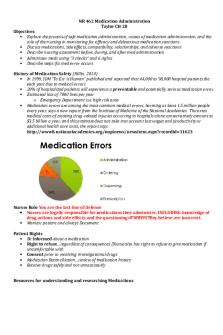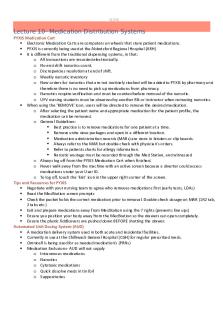Medication Administration PDF

| Title | Medication Administration |
|---|---|
| Author | Jordan Wentworth |
| Course | Fundamentals Of Nursing |
| Institution | University of North Alabama |
| Pages | 3 |
| File Size | 105 KB |
| File Type | |
| Total Downloads | 5 |
| Total Views | 134 |
Summary
Medication administration and pharmacokinetics....
Description
Medication Administration Objectives (pg. 609) 1. Discuss nursing roles & responsibilities in medication administration - Preparing, administering, and evaluation of the effects of medications (how they affect the patient's health status) - Knowing pharmacokinetics to time med administration, route of administration, & evaluating patient response - Teaching patients about side effects - Encouraging them to follow the medication regimen - Evaluating the family/caregiver's ability to administer medications if needed 2. Describe the physiology mechanisms of medication action 3. Forms of medications Form
Description
Oral Route: Solid forms ●
Caplet
Solid, shaped like a capsule & coated for easy swallowing
●
Capsule
Encased in a gelatin shell
●
Tablet
Compressed powder; as binders (adhesive for the powder to stick together), disintegrators (helps tablet dissolve), lubricants, and fillers
●
Enteric-coated tablets
Dissolves & absorbs in intestines, NOT stomach
Oral Route: Liquid forms ●
Elixir
Clear fluid with water/alcohol; sweetened
●
Extract
Concentrated, made from removing the active med from its other components
●
Aqueous solution
Substance dissolved in water/syrups
●
Aqueous suspension
Finely dissolved drug particles in liquid medium (settle on bottom when sets)
●
Syrup
Meds dissolved in a concentrated sugar solution
●
Troche (lozenge)
Flat/round tablet that dissolves in mouth
●
Aerosol
Sprayed/absorbed in mouth & upper airway
●
Sustained release
Tablet/capsule with small coated particles of a med that need a varying amount of time to dissolve
Topical Route ●
Ointment
Usually has 1 or more meds
●
Liniment
Has alcohol, oil, or soapy emollient applied to skin
●
Lotion
Protects, coats or cleanses skin
●
Paste
Absorbed more slowly than ointment; used for skin protection
●
Transdermal disk/patch
Absorbed slowly over a long period of time
Parenteral Route ●
Solution
Water with 1 or more dissolved components
●
Powder
Dissolved in a sterile liquid (water, normal saline) before administration
Body Cavities ●
Intraocular disk
Small, flexible oval with 2 soft outer layers & a middle layer with medication (slowly releases meds when moistened by ocular fluid)
●
Suppository
Solid dosage mixed with gelatin & shaped in pellet form for insertion (melts when reaches body temp., releasing med for absorption)
4. 5. 6. -
-
-
Differentiate among different types of medication actions Therapeutic effects Adverse effects Discuss developmental factors that influence pharmacokinetics Discuss factors that influence medication actions How a medication is absorbed - Route of administration: - Skin = slow absorption - Orally = slow due to passing through GI tract - Mucous membranes/airways = quick; tissues have more blood vessels - IV injection = quickest, immediate response due to entering systemic circulation - Ability of a med to dissolve: - Solutions/suspensions already in liquids absorb faster than tablets/capsules - Acidic meds go through GI tract quickly - Basic meds are not absorbed before getting to small intestine - Blood flow to the site of administration: - Greater the blood supply, the faster the med is absorbed (med is absorbed once blood reaches administration site) - Body surface area (BSA): - Meds absorbed faster when in contact with a larger surface area - Lipid solubility: - Lipid-soluble meds cross cell membrane quicker - Food in the stomach affects absorption - ALWAYS check with pharmacology books, package inserts/pharmacy BEFORE giving a patient a med to see what the medication-medication or medication-food interactions exist How a medication is distributed - Circulation: - Vascularity of a patient's tissues/organs determines how fast a med is distributed - Low vascularity = slow distribution - Membrane permeability: - Medication's ability to pass through tissues/membranes of target cells - Protein binding: - How meds bind to serum proteins affects distribution (most partially bind, reducing its effect) How a medication is metabolised - Patients with liver disease can have toxic reactions to drugs because more of them accumulate in the body due to liver's decreased ability to break down harmful substances before distributed to tissues
-
How a medication is excreted - Adequate fluid intake helps proper elimination of meds for adults (50 mL/kg/hr) - Impaired renal function limits the kidney's ability to properly excrete meds → increasing risk for medication toxicity 7. Discuss methods used to educate patients about prescribed medications 8. Compare and contrast the roles of the health care provider, pharmacist, and nurse in medication administration 9. Implement nursing actions to prevent medication errors 10. Describe factors to consider when choosing routes of medication administration - The form and composition of the medication (determines route of administration, absorption & metabolism) 11. Calculate prescribed medication does correctly 12. Discuss factors to include in assessing a patient's needs for and response to medication therapy 13. Identify the 6 rights of medication administration and apply them in clinical settings 14. Correctly and safely prepare and administer medications 1. Pharmacokinetics - Absorption: the passage of medication into the blood from its site of administration - Oral drugs have a slow absorption - IV drugs have the most rapid absorption - Liquids absorb faster than tablets - Food may interfere with absorption - Some meds interfere with absorption of other meds - Distribution: medications are distributed into the body - Circulation - Membrane permeability - Protein binding - Metabolism: - Most of the drug is metabolized in the liver...but also in the lungs, kidneys, intestines, and blood - Excretion: after medications are metabolized, they exit the body through the kidneys, liver, bowel, exocrine glands, and lungs...
Similar Free PDFs

Medication Administration
- 3 Pages

Medication Administration
- 6 Pages

Chapter 31 Medication Administration
- 18 Pages

Chapter 31 Medication Administration
- 27 Pages

Test 1 Medication Administration
- 9 Pages

Chapter 35 Medication Administration
- 16 Pages
Popular Institutions
- Tinajero National High School - Annex
- Politeknik Caltex Riau
- Yokohama City University
- SGT University
- University of Al-Qadisiyah
- Divine Word College of Vigan
- Techniek College Rotterdam
- Universidade de Santiago
- Universiti Teknologi MARA Cawangan Johor Kampus Pasir Gudang
- Poltekkes Kemenkes Yogyakarta
- Baguio City National High School
- Colegio san marcos
- preparatoria uno
- Centro de Bachillerato Tecnológico Industrial y de Servicios No. 107
- Dalian Maritime University
- Quang Trung Secondary School
- Colegio Tecnológico en Informática
- Corporación Regional de Educación Superior
- Grupo CEDVA
- Dar Al Uloom University
- Centro de Estudios Preuniversitarios de la Universidad Nacional de Ingeniería
- 上智大学
- Aakash International School, Nuna Majara
- San Felipe Neri Catholic School
- Kang Chiao International School - New Taipei City
- Misamis Occidental National High School
- Institución Educativa Escuela Normal Juan Ladrilleros
- Kolehiyo ng Pantukan
- Batanes State College
- Instituto Continental
- Sekolah Menengah Kejuruan Kesehatan Kaltara (Tarakan)
- Colegio de La Inmaculada Concepcion - Cebu









